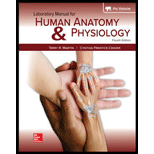
Concept explainers
To explain:
Summary of the visual tests of the persons.
Introduction:
The eye is a three-layered, fluid filled ball divided into two chambers. The sclera forms a white capsule around the eye, except at its anterior surface where it is specialized into clear cornea. The tough, fibrous sclera serves as the insertion point for external muscles that more the eyeballs within their sockets. A portion of the underlying choroid layer is darkly pigmented to absorb light rays at the back of the eyeball. In the front, the choroid layer is specialized into the iris (the structure that gives your eyes their color), the ciliary muscle, and the zonular fibers. Circular and radial smooth muscle fibers of the iris determine the diameter of the pupil, the anterior opening that allows light into the eye. The ciliary muscles determine the shape and focusing power of the crystalline lens just behind the iris. The retina is formed from an extension of the developing brain in fetal life on which the real and inverted image is formed. The eye is divided into two fluid-filled spaces- the aqueous humor between the iris and cornea and vitreous humor between lens and the retina.
The human eye is designed to see both near and far objects. The near point of the human eye is the minimum distance up to which the eye can see clearly without strain. For a healthy human eye, this distance is 25 cm. The far point of the human eye is the maximum distance up to which the eye can see clearly. For a healthy human eye, this distance is infinity.
Want to see the full answer?
Check out a sample textbook solution
Chapter 36 Solutions
Laboratory Manual For Human Anatomy & Physiology
- discussion on obejective lenses: screening, low and high power objectives in an onion root tiparrow_forwardGive the resolution of eyepiece, scanning objective, LPO, HPO and OIOarrow_forwardWhat should be the distance between Mr. Saleto and the Snellen chart? 6ftaway What instructions can Casey give to Mr. Saleto if he uses glasses? By using the Snellen chart, is Cassey testing distance or near visual acuity? What does it mean if the result of the test is 20/60? What are some nonverbal cues that may indicate that the patient is having difficulty reading the line to which Cassey is pointing?arrow_forward
- Why is masking of the non-test ear recommended and used in speech audiometric assessment using supra-aural headphones, especially when the client being tested has normal hearing sensitivity? (Hint: What is inter-aural attenuation, and how does this affect the testing paradigm?)arrow_forwardDiscuss the applications,benefitsand limitations of ultra-sonography techniques. You will need to consider issues such as cost, safety and image quality.arrow_forwardDefine Spirometry Confirmation of Dynamic Compression? Quickly answerarrow_forward
- Understanding Health Insurance: A Guide to Billin...Health & NutritionISBN:9781337679480Author:GREENPublisher:CengageCase Studies In Health Information ManagementBiologyISBN:9781337676908Author:SCHNERINGPublisher:Cengage


